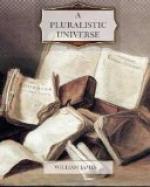The difference I try to describe amounts, you see, to nothing more than the difference between what I formerly called the each-form and the all-form of reality. Pluralism lets things really exist in the each-form or distributively. Monism thinks that the all-form or collective-unit form is the only form that is rational. The all-form allows of no taking up and dropping of connexions, for in the all the parts are essentially and eternally co-implicated. In the each-form, on the contrary, a thing may be connected by intermediary things, with a thing with which it has no immediate or essential connexion. It is thus at all times in many possible connexions which are not necessarily actualized at the moment. They depend on which actual path of intermediation it may functionally strike into: the word ‘or’ names a genuine reality. Thus, as I speak here, I may look ahead or to the right or to the left, and in either case the intervening space and air and ether enable me to see the faces of a different portion of this audience. My being here is independent of any one set of these faces.
If the each-form be the eternal form of reality no less than it is the form of temporal appearance, we still have a coherent world, and not an incarnate incoherence, as is charged by so many absolutists. Our ‘multiverse’ still makes a ‘universe’; for every part, tho it may not be in actual or immediate connexion, is nevertheless in some possible or mediated connexion, with every other part however remote, through the fact that each part hangs together with its very next neighbors in inextricable interfusion. The type of union, it is true, is different here from the monistic type of all-einheit. It is not a universal co-implication, or integration of all things durcheinander. It is what I call the strung-along type, the type of continuity, contiguity, or concatenation. If you prefer greek words, you may call it the synechistic type. At all events, you see that it forms a definitely conceivable alternative to the through-and-through unity of all things at once, which is the type opposed to it by monism. You see also that it stands or falls with the notion I have taken such pains to defend, of the through-and-through union of adjacent minima of experience, of the confluence of every passing moment of concretely felt experience with its immediately next neighbors. The recognition of this fact of coalescence of next with next in concrete experience, so that all the insulating cuts we make there are artificial products of the conceptualizing faculty, is what distinguishes the empiricism which I call ‘radical,’ from the bugaboo empiricism of the traditional rationalist critics, which (rightly or wrongly) is accused of chopping up experience into atomistic sensations, incapable of union with one another until a purely intellectual principle has swooped down upon them from on high and folded them in its own conjunctive categories.




